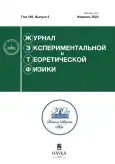STRONG NEGATIVE MAGNETORESISTANCE AND HOPPING TRANSPORT IN GRAPHENIZED NEMATIC AEROGELS
- Autores: Tsebro V.I.1,2, Nikolaev E.G.2, Kutuzov M.S.3, Sadakov A.V.1, Sobolevskiy O.A.1
-
Afiliações:
- Lebedev Physical Institute, Russian Academy of Sciences
- Kapitsa Institute for Physical Problems, Russian Academy of Sciences
- Metallurg Engineering Ltd.
- Edição: Volume 165, Nº 2 (2024)
- Páginas: 266-275
- Seção: Articles
- URL: https://bakhtiniada.ru/0044-4510/article/view/256486
- DOI: https://doi.org/10.31857/S0044451024020123
- ID: 256486
Citar
Resumo
The transport properties of nematic aerogels, which consist of oriented mullite nanofibers coated with a graphene shell, were studied. It is shown that the magnetoresistance of this system is well approximated by two contributions – negative one, described by the formula for systems with weak localization, and positive contribution, linear in the field and unsaturated in large magnetic fields. The behavior of phase coherence length on temperature obtained from the analysis of the negative contribution indicates the main role of the electron-electron interaction in the destruction of phase coherence and, presumably, the transition at low temperatures from a two-dimensional weak localization regime to a one-dimensional one. The positive linear contribution to magnetoresistance is apparently due to the inhomogeneous distribution of the local carrier density in the conductive medium. It has also been established that the temperature dependence of the resistance for graphenized aerogels with a low carbon content, when the graphene coating is apparently incomplete, can be represented as the sum of two contributions, one of which is characteristic of weak localization, and the second is described by hopping mechanism corresponding to the Efros-Shklovskii law in the case of a granular conductive medium. For samples with a high carbon content, there is no second contribution.
Palavras-chave
Sobre autores
V. Tsebro
Lebedev Physical Institute, Russian Academy of Sciences; Kapitsa Institute for Physical Problems, Russian Academy of Sciences
Email: v.tsebro@mail.ru
Rússia, 119991 Moscow; 119334 Moscow
E. Nikolaev
Kapitsa Institute for Physical Problems, Russian Academy of Sciences
Email: nikolaev@kapitza.ras.ru
Rússia, 119334, Moscow
M. Kutuzov
Metallurg Engineering Ltd.
Email: v.tsebro@mail.ru
Estônia, 11415, Tallinn
A. Sadakov
Lebedev Physical Institute, Russian Academy of Sciences
Email: v.tsebro@mail.ru
Rússia, 119991, Moscow
O. Sobolevskiy
Lebedev Physical Institute, Russian Academy of Sciences
Autor responsável pela correspondência
Email: v.tsebro@mail.ru
Rússia, 119991, Moscow
Bibliografia
- I. Hussainova, R. Ivanov, S. N. Stamatin et al., Carbon 88, 157 (2015).
- R. Ivanov, V. Mikli, J. K¨ubarsepp and I. Hussainova, Key Engin. Mater. 674, 77 (2016).
- V. S. Solodovnichenko, M. M. Simunin, D. V. Lebedev et al., Thermochim. Acta 675, 164 (2019).
- В. И. Цебро, Е. Г. Николаев, Л. Б. Луганский и др., ЖЭТФ 161, 266 (2022).
- S. Hikami, A.I. Larkin and Y. Nagaoka, Prog. Of Theor. Phys. 63, 707 (1980).
- P. A. Lee and T. V. Ramakrishnan, Rev. Mod. Phys. 57, 287 (1985).
- N. Ramakrishnan, Y. T. Lai, S. Lara et al., Phys. Rev. B 96, 224203 (2017).
- J. Ping, I. Yudhistira, N. Ramakrishnan et al., Phys. Rev. Lett. 113, 047206 (2014).
- A. Narayanan, M. D.Watson, S. F. Blake et al., Phys. Rev. Lett. 114, 117201 (2015).
- W. L. Zhu, Y. Cao, P. J. Guo et al., Phys. Rev. B 105, 125116 (2022).
- A. L. Friedman, J. L. Tedesco, P. M. Campbell et al., Nano Lett. 10, 3962, (2010).
- F. Kisslinger, C. Ott, C. Heide et al., Nat. Phys. 11, 650 (2015).
- S. Gu, K. Fan, Y. Yang et al., Phys. Rev. B 104, 115203 (2021).
- Б. И. Шкловский, А. Л. Эфрос, Электронные свойства легированных полупроводников, Наука, Москва (1979).
- B. I. Shklovskii and A. L. Efros, in Electronic Properties of Doped Semiconductors, Vol. 45 of Springer Series in Solid-State Sciences, Springer-Verlag, Berlin, Heidelberg GmbH (1984).
- J. Zhang and B. I. Shklovskii, Phys. Rev. B 70, 115317 (2004).
- I. S. Beloborodov, A. V. Lopatin, V. M. Vinokur, and K. B. Efetov, Rev. Mod. Phys. 79 469 (2007).
- T. Hu and B. I. Shklovskii, Phys. Rev. B 74, 054205 (2006).
- T. Hu and B. I. Shklovskii, Phys. Rev. B 74, 174201 (2006).
- I. L. Aleiner, B. L. Altshuler, and M. E. Gershenson, Waves in Random Media 9, 201 (1999).
- L. Piraux, F. Abreu Araujo, T. N. Bui et al., Phys. Rev. B 92, 085428 (2015).
- B. L. Altshuler, A. G. Aronov, and D. E. Khmelnitsky, J. Phys. C: Sol. St. Phys. 15, 7367 (1982).
- S. Lara-Avila, A. Tzalenchuk, S. Kubatkin et al., Phys. Rev. Lett. 107, 166602 (2011).
- A. M. R. Baker, J. A. Alexander-Webber, T. Altebaeumer et al., Phys. Rev. B 86, 235441 (2012).
- F. V. Tikhonenko, D. W. Horsell, R. V. Gorbachev, and A. K. Savchenko, Phys. Rev. Lett. 100, 056802 (2008).
- D.-K. Ki, D. Jeong, J.-H. Choi et al., Phys. Rev. B 78, 125409 (2008).
- R. Tarkiainen, M. Ahlskog, A. Zyuzin et al., Phys. Rev. B 69 033402 (2004).
- F. V. Tikhonenko, A. A. Kozikov, A. K. Savchenko, and R. V. Gorbachev, Phys. Rev. Lett. 103 226801 (2009).
- R. Xu, A. Husmann, T. F. Rosenbaum et al., Nature 390 57 (1997).
- A. Husmann, J. B. Betts, G. S. Boebinger et al., Nature 417, 421 (2002).
- M. M. Parish and P. B. Littlewood, Nature 426, 162 (2003).
- M. M. Parish and P. B. Littlewood, Phys. Rev. B 72, 094417 (2005).
- V. Guttal and D. Stroud, Phys. Rev. B 71, 201304 2005.
Arquivos suplementares









